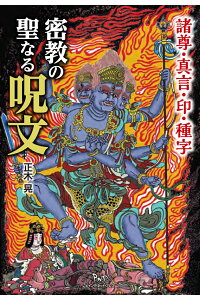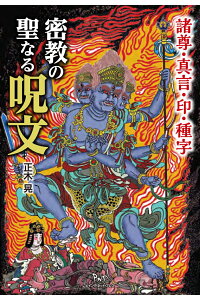正木晃著「密教の聖なる呪文」ビイング・ネット・プレス
お寺に行くと、仏様の前に真言(呪文)が書かれていることがあります。祈る際に3回唱えよとか、注意書きがあると思います。前々から気になっていたので、自分の守護仏である大日如来の真言ぐらいは憶えておきたいと思い、この本を購入しました。ただし、あまり家の中で声に出して唱えていると、家族から、いよいよ怪しくなったと勘ぐられるので、ほどほどにしておきましょう。以下、本書の内容を少し紹介します。
基本的なところで、般若心経の一節、羯諦 羯諦 波羅羯諦 波羅僧羯諦 菩提薩婆訶
(ぎゃてい ぎゃてい はらぎゃてい はらそうぎゃてい ぼうじそわか)を聞いたことがありませんか?般若心経を覚えていなくても、「ぎゃてい、ぎゃてい」だけは耳に残っている人も多いでしょう。意味は、「行った者よ。行った者よ。悟りの世界へ行った者よ。悟りの世界へ完全に行き着いた者よ。幸いあれ」だそうです。サンスクリット語の発音では、「
ガテー ガテー バーラガテー バーラサンガテー ボーディスヴァーハー」らしいのですが、別に日本語読みでも問題ないそうです。(本当にそれで通じているのか、私は疑問を持ってしまいますが。)
ちなみに、古来もっとも効験あらたかな真言は、阿弥陀如来の「根本真言」とされてきたそうです。この真言は、「甘露」もしくは「不死不滅」を意味する「アムリタ(あみりた)」を十回くり返すものです。
真言とは関係ないのですが、不動明王には2種類あることをこの本で知りました。1つは、「両目を見開き上の歯で下唇をかみしめているタイプ」で、大日如来の化身という性格をあらわした事例です。空海が鎮護国家のヒーローに位置づけた不動明王です。
もう一つは、「両目が異なった方向を見て、上下左右に牙を出しているタイプ」で、古代インドの奴隷だった原初の姿にもどった事例で、個人的な護身を期待された不動明王です。
空海や最澄が活躍していた時代では、宗教は公的領域と私的領域の両方にかかわるものであり、公的領域が私的領域に優先するというのが、むしろ常識だったそうです。鎌倉新仏教でも、この傾向は明らかで、臨済宗の栄西の主著は興禅護国論。曹洞宗の祖師、道元にも『護国正法義』という著作があり、日蓮は『立正安国論』を書きました。
江戸時代における修験道は、今では想像しがたいほど大きかったそうです。意外ですが、江戸時代の中期まで、飛鳥の法隆寺は、南都(奈良)修験の拠点寺院でした。同じく奈良の興福寺や薬師寺も、南都修験の拠点でした。今でも、薬師寺では、同時だけに伝わる水式護摩という独特な方法で、護摩を焚いています。(完)

価格:2,200円
(2021/5/15 16:41時点)
感想(0件)
“Sacred Spells of Esoteric Buddhism” by Akira Masaki, Being Net Press.
When you visit a temple, you may find a mantra (incantation) written in front of the Buddha. I think there is a note saying to chant it three times when praying or something like that. I had been curious about this for a long time, so I bought this book because I wanted to remember at least the mantra of Dainichi Nyorai, my guardian Buddha. However, if you chant it aloud in the house too often, your family may suspect that you have finally become dangerous, so please keep it to a moderate level. Below is a brief introduction to the contents of this book.
The basic passage in the Heart Sutra, 羯諦, 羯諦, 哈羅羯諦, 哈羅僧羯諦, 菩提薩婆訶
Have you ever heard “Gyatei, gyatei, hara gyatei, haraso gyatei, benjisowaka” (Gyatei, gyatei, haraso gyatei, benjisowaka)? Even if you don’t remember the Heart Sutra, you may have heard only “Gyatei, Gyatei”. It means, “O you who have gone. You who have gone, you who have gone. You who have gone to the world of enlightenment. O one who has completely reached the world of enlightenment. Blessed are you. In Sanskrit, it is pronounced “Gathee Gathee Bharagathee Bharasangathee Bodisvaha,” but I have heard that the Japanese pronunciation is fine. (I doubt if it is really understood.)
Incidentally, the most effective mantra since ancient times has been the “fundamental mantra” of the Amida Buddha. This mantra consists of repeating the word “Amrita” ten times, which means “nectar” or “immortality and immortality.
Although unrelated to the Shingon, I learned from this book that there are two types of Fudo Myoo, one with both eyes wide open and upper teeth biting the lower lip, an example of his character as an incarnation of Dainichi Nyorai. This is the Fudo Myoo, whom Kukai positioned as the hero of the state of tranquility.
The other is the “type with both eyes looking in different directions and with fangs out in both directions, up, down, left, and right,” an example of a return to the primordial form of the ancient Indian slaves, the Fudo Myoo, who was expected to provide personal protection.
In the period when Kukai and Saicho were active, it was rather common knowledge that religion involved both the public and private spheres, and that the public sphere took precedence over the private. This tendency was evident even in the new Buddhism of the Kamakura period, and Eisai of the Rinzai sect was the main author of the Kozen Gokoku-ron. Dogen, the founder of the Soto sect, also wrote a work entitled “Gokoku Sho Hogi” (Gokoku Sho Hogi), and Nichiren wrote “Rissho Ankoku Ron” (Rissho Ankoku Ron).
Shugendo in the Edo period was so large that it is hard to imagine today. Surprisingly, until the mid-Edo period, Horyuji Temple in Asuka was the center of Nanto (Nara) Shugendo. Kofukuji and Yakushiji temples, also in Nara, were also centers of Nanto Shugen. Even today, Yakushiji Temple still burns goma using a unique method called mizushiki goma, which has been handed down only at the same time. (End)
“Sacred Spells of Esoteric Buddhism” par Akira Masaki, Being Net Press.
Lorsque vous visitez un temple, vous pouvez trouver un mantra (incantation) écrit devant le Bouddha. Je crois qu’il y a une note qui dit de le chanter trois fois en priant ou quelque chose comme ça. Cela m’intéressait depuis longtemps et j’ai acheté ce livre parce que je voulais me souvenir au moins du mantra de Dainichi Nyorai, mon bouddha gardien. Cependant, si vous le chantez à haute voix dans la maison trop souvent, votre famille pourrait soupçonner que vous êtes finalement devenu dangereux, alors veuillez le garder à un niveau modéré. Vous trouverez ci-dessous une brève introduction au contenu de ce livre.
Le passage fondamental du Soutra du cœur, 羯諦, 羯諦, 哈羅羯諦, 哈羅僧羯諦, 菩提薩婆訶
vez-vous déjà entendu “Gyatei, gyatei, hara gyatei, haraso gyatei, benjisowaka” (Gyatei, gyatei, haraso gyatei, benjisowaka) ? Même si vous ne vous souvenez pas du Sutra du Cœur, vous avez peut-être entendu seulement “Gyatei, Gyatei”. Cela signifie : “O vous qui êtes partis. Toi qui es parti, toi qui es parti. Toi qui es allé dans le monde de l’illumination. O celui qui a complètement atteint le monde de l’illumination. Tu es béni. En sanskrit, cela se prononce “Gathee Gathee Bharagathee Bharasangathee Bodisvaha”, mais j’ai entendu dire que la prononciation japonaise était correcte. (Je doute qu’elle soit vraiment comprise).
Par ailleurs, le mantra le plus efficace depuis les temps anciens est le “mantra fondamental” du Bouddha Amida. Ce mantra consiste à répéter dix fois le mot “Amrita”, qui signifie “nectar” ou “immortalité et immortalité”.
Bien que sans rapport avec le Shingon, j’ai appris dans ce livre qu’il existe deux types de Fudo Myoo, l’un avec les deux yeux grands ouverts et les dents supérieures mordant la lèvre inférieure, un exemple de son caractère d’incarnation de Dainichi Nyorai. C’est le Fudo Myoo, que Kukai a positionné comme le héros de l’état de tranquillité.
L’autre est le “type dont les deux yeux regardent dans des directions différentes et dont les crocs sortent dans les deux sens, vers le haut, le bas, la gauche et la droite”, un exemple de retour à la forme primordiale des anciens esclaves indiens, le Fudo Myoo, qui devait assurer la protection personnelle.
À l’époque où Kukai et Saicho étaient actifs, il était plutôt communément admis que la religion impliquait à la fois la sphère publique et la sphère privée, et que la sphère publique primait sur la sphère privée. Cette tendance était évidente même dans le nouveau bouddhisme de la période Kamakura, et Eisai de la secte Rinzai était le principal auteur du Kozen Gokoku-ron. Dogen, le fondateur de la secte Soto, a également écrit un ouvrage intitulé “Gokoku Sho Hogi” (Gokoku Sho Hogi), et Nichiren a écrit “Rissho Ankoku Ron” (Rissho Ankoku Ron).
Le shugendo de la période Edo était si vaste qu’il est difficile de l’imaginer aujourd’hui. Étonnamment, jusqu’au milieu de la période Edo, le temple Horyuji à Asuka était le centre du shugendo de Nanto (Nara). Les temples Kofukuji et Yakushiji, également à Nara, étaient également des centres du Nanto Shugen. Aujourd’hui encore, le temple Yakushiji brûle du goma selon une méthode unique appelée mizushiki goma, qui n’a été transmise qu’à cette époque. (Fin)
